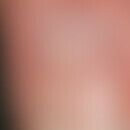Synonym(s)
DefinitionThis section has been translated automatically.
Rare, nonbullous, autosomal recessive, congenital lamellar ichthyosis causally due to transglutaminase 1 deficiency. S.a.u. Transglutaminases. S.a. Overview chapter: Autosomal recessive congenital ichthyoses.
Occurrence/EpidemiologyThis section has been translated automatically.
The disease is rare with a prevalence of 1,50,000 - 1:60,000.
You might also be interested in
EtiopathogenesisThis section has been translated automatically.
Autosomal recessive inherited defects of the transglutaminase 1gene (TGM1 gene; gene locus: 14q11.2), the enzyme for building the cornified cell envelope. A correlation between the clinical severity and the type of mutation can be established. In the ggroup of autosomal recessive congenital ichthyoses there is a high proportion of mutations in the TGM1. Gene (about 40%). 60% falls on phenotypes with preserved transglutaminase activity with diverse mutations of which the mutations in ALOXE3, ALOX12, CYP4F22 and NIPL4 are the most frequent.
A peculiarity in the group of patients with lamellar ichthyosis and congenital ichthyosiform erythroderma with mutation in TGM1 (transglutaminase deficiency) are 2 clinical variants.
- In about 10% of children with collodion skin or congenital ichthyosiformer erythroderma, there is extensive healing of the ichthyosis within the first 3 months of life. The cause is a pressure-sensitive mutation in the transglutaminase gene(self-improving congenital ichthyosis).
- In the 2nd variant of"bathing suit ichthyosis" cooler skin areas heal, i.e. arms, legs, buttocks and face heal. The cause is a temperatiusensitive mutation in the transglutaminase gene.
ManifestationThis section has been translated automatically.
From birth, appearing under the picture of erythroderma (congenital ichthyosiform erythroderma).
ClinicThis section has been translated automatically.
Diffuse, usually very marked, but occasionally more discrete, generalized, brownish-blackish scaling involving the scalp as well as the flexures of the joints. Erythroderma with fine, white, loose scales or discrete erythema beneath the overlying scaling may occur. Prominent, planar or insular palmo-plantar keratoses (see also autosomal dominant lamellar ichthyosis), often associated with painful fissures, digital contractures, onychodystrophy, and subungual hyperkeratoses. Usually loss of eyebrows. Sweat production may be decreased; skin condition may worsen under UV irradiation.
DiagnosisThis section has been translated automatically.
External therapyThis section has been translated automatically.
Nourishing, hydrating and keratolytic external agents such as 5-10% urea and possibly 10% lactic acid. The use of external retinoids causes relatively frequent irritations. Good results have been described with the external application of acetylcysteine in ointment base R003. S.u. Ichthyosis vulgaris, autosomal dominant. S.a.u. autosomal dominant lamellar ichthyosis.
Internal therapyThis section has been translated automatically.
Note(s)This section has been translated automatically.
Remember! For the diagnosis a non-formalin-fixed biopsy (skin sample unfixed on dry ice) is necessary, on which a direct activity determination of the transglutaminase can be carried out (AG Prof. Traupe/University Dermatology Clinic Münster).
LiteratureThis section has been translated automatically.
- Akiyama M et al (2003) The clinical spectrum of nonbullous congenital ichthyosiform erythroderma and lamellar ichthyosis. Clin Exp Dermatol 28: 235-240
- DiGiovanna JJ et al (2003) Ichthyosis: etiology, diagnosis, and management. At J Clin Dermatol 4: 81-95
- Esposito G et al (2001) Transglutaminase 1 gene mutations in Italian patients with autosomal recessive lamellar ichthyosis. J Invest Dermatol 116: 809-812
- Ganemo A et al (2003) Autosomal recessive congenital ichthyosis in Sweden and Estonia: clinical, genetic and ultrastructural findings in eighty-three patients. Acta Derm Venereol 83: 24-30
Incoming links (6)
Acetylcysteine cream (w/o), low water; Bathing suit ichthyosis; Cornified envelope; Dermatitis herpetiformis; Leiner's disease; Transglutaminases;Outgoing links (16)
Acetylcysteine cream (w/o), low water; Acitretin; Autosomal recessive congenital ichthyosis; Bathing suit ichthyosis; Cornified envelope; Erythrodermia; Fissure; Ichthyosis vulgaris; Lactic acid; Onychodystrophy (overview); ... Show allDisclaimer
Please ask your physician for a reliable diagnosis. This website is only meant as a reference.




